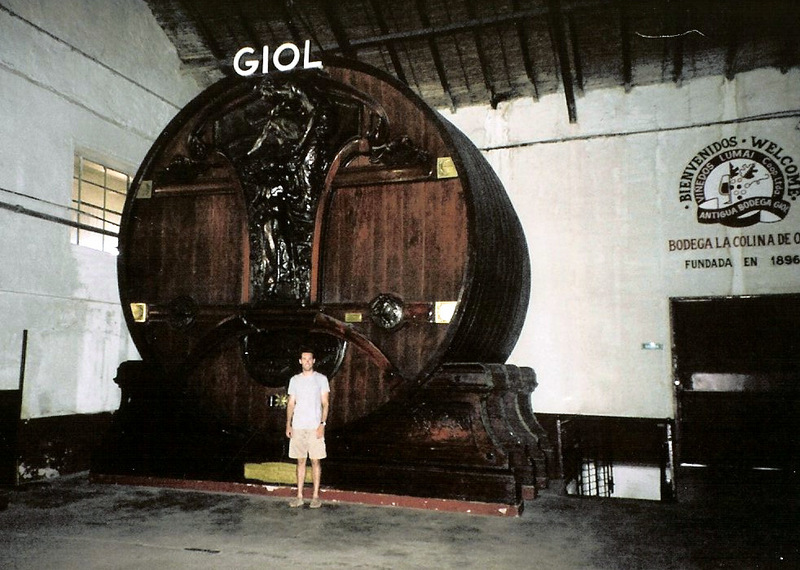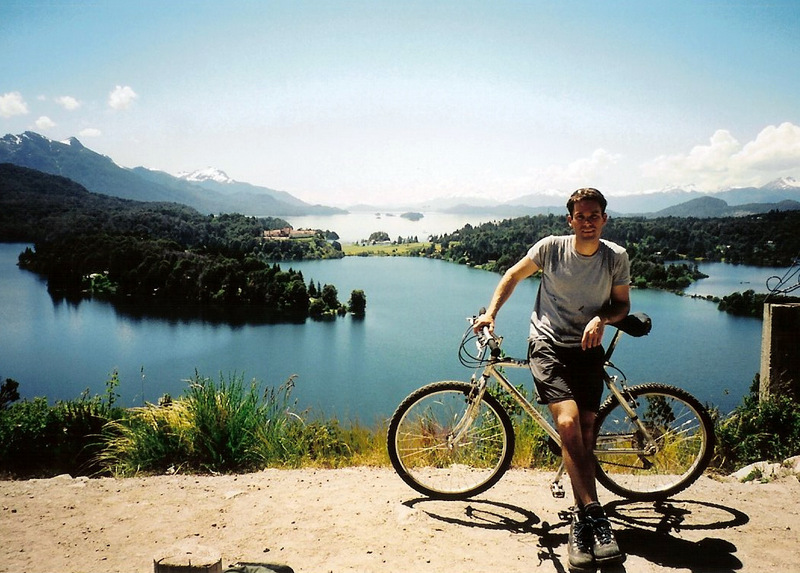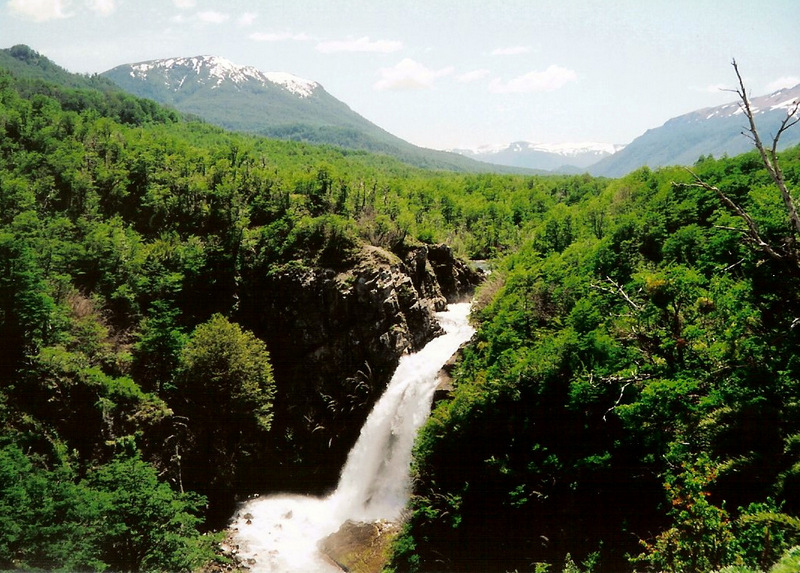
12 Dec 2002
I’m in Mendoza, beautiful Mendoza! What a welcome relief from the tourist-trodden Lake District. This is a spotlessly clean city; shopkeepers seem to sweep constantly (although this unfortunately makes for some dusty air when passing by). And it has beautiful plazas, with grand elephant palms, regal statues, splashy fountains, and plenty of benches perched conveniently beneath shady trees and alongside blooming flower beds. The acequias (irrigation canals) that line nearly every street add a distinctive flavor to the city (but also pose somewhat of a danger if one were to misstep), as well as nourish to the trees that provide much-needed shade during the blistering midday siesta hours.
The canals are leftover from the indigenous Huarpes who ingeniously turned a virtual desert into a thriving agricultural zone (which the Spaniards were quick to capitalize on) by effectively channeling the runoff from the Andes to the West. Despite many earthquakes over the centuries, it still has some decent colonial buildings. Agreeably familiar, it feels very much like southern Spain.
It is a hot climate here (today was in the 90’s) but due to the extensive irrigation canals it is the heart of Argentina’s wine district. I spent the day touring the local bodegas (wineries) in the adjacent Maipú valley, hitting some very interesting ones that date from the late 1800’s (almost all were started by Italian or Spanish immigrants). Most of the buildings are original and include wonderful huge oak casks from France used for aging the reds (mostly Malbec). Some bodegas include extensive wine museums with artifacts dating from the colonial period and tours of the casas patronales (owners’ homes) which are indeed grand, if not somewhat faded. And of course the compulsory post-tour wine tasting, which I discovered are in every case exceedingly generous.

The Maipú region is very close to Mendoza, and the local buses provide easy transport to and between the various wineries. Well, easy if one were not to imbibe in the voluminous tastings (unlike myself) so I once found myself a bit lost in the hinterland — not a bad place to be, considering the day was warm and bright, the landscape serene (accented with flower-fronted farmhouses, olive groves, and green cornfields), and the locals friendly. So friendly that a mother-daughter duo took pity on me, scooped me up into their sporty car, and whisked me off to the next bodega. The tours are really pleasant, with rarely a hard sell at the end. Most of the wineries are quite sophisticated using the latest viticultural (great word!) technology, while others are still family-run enterprises or farmer cooperatives that produce strictly for local consumption.
Last evening I spent hours in the sidewalk cafes, sipping wine, reading a great Argentine book that was recommended to me, and watching the Mendocino world go by, including the street protests, which I haven’t seen since Buenos Aires. These are always peaceful affairs, usually of several dozen people and with large banners protesting political corruption, companies that fired workers, and of course the heavy-handed banks. Always the chants are accompanied by boisterous drumming and whistling (called murga), hosting instruments of the marching band variety, as well as kitchen wares: tin cups & plates, pots, even a coffee percolator. Sometimes they seem like angry affairs, but the frustration is directed towards political or financial institutions, and there is always (albeit marginal) a police presence if things get out of hand, which I understand is rare.
Protests aside, Mendoza’s evening vitality sharply contrasts the still afternoon hours, when all stores close and the streets empty. Around 4 PM the sidewalks are slowly awakened by the sweeping shopkeepers. By 6 PM most of the business is done for the day, and by 8 PM the streets are merry with pedestrians, the cafes full, and throngs of youth line up outside the heladerías (ice cream stands) and rockerías (stores selling rock-n-roll paraphernalia: band T-shirts, buttons with sassy sayings, etc).
Finally by 10 PM the masses move from the cafes to the restaurants, but the last few nights I haven’t been up to observe this. I did make it to a local showing of an independent Argentine film, El bonarense (“The Buenos Arian”), that premiered at Cannes. It was interesting in two ways: since the currency crisis last year, independent films in the country have suffered greatly (so the appearance of this was an accomplishment in itself), and the subject matter dealt with the Argentine country underclass who migrate to the Buenos Aires metropolis. I thought it a worthy film although somewhat weighty (in the great cinéma-vérité tradition). Certainly more worthwhile than that Hollywood trash that seems just about everywhere.
This week I had what I thought was a simple cold, but turned nasty after I biked 60 km through the mountains last weekend. The next morning I felt terrible, so instead of commencing a much-anticipated trek in the Lake District, I had to take it easy so I slept a lot and finally had it under control. Now in Mendoza I feel great, have an awesome hotel (at first I hesitated since it sounded so expensive — 49 pesos! — compared to the usual 20-25 pesos I normally pay, but then I did the math and 49 pesos is only $14 USD for a really comfy hotel, like so cushy I would never stay here under “normal” circumstances). So my arrival in Mendoza has coincided with good health and therefore my impressions are grand.
I was less impressed with the Lake District, partly due to my lethargy, loss of appetite, and inability to speak Spanish (strange how when I am under the weather my Spanish is horrible — so bad, apparently, that the locals take pity on me and start answering me in English, which is unusual!).
I liked El Bolsón a lot (the hippy town), but Bariloche — the ski capital of Argentina — was really kind of drab. Many of the large hotels and restaurants have closed (and have nasty graffiti painted on the windows from frustrated ex-employees), and seemingly every fourth shop is vacant with a “for lease” sign. If the currency troubles in Argentina weren’t enough, the past ski season was very bad (the snow came very late) and even the Argentines didn’t come. So what the guidebook describes as quite a throbbing city really was quite depressed (in fact many of the places to stay or eat listed in the book have closed). But despite this, the town itself is really a huge tourist town, full of curio shops, adventure tour agencies, overpriced restaurants, etc.

The scenery is quite nice indeed, and as mentioned I managed to complete the popular Circuito Chico (literally the “Short Circuit”) tour on bicycle, which I had a hard time finding since all the bike agencies were closed on Sunday. Not so at the youth hostel, which was full of gregarious Argentine youths making ice cream (it was yummy!) and had plenty of serviceable bikes for rent for the day — you can always count on youth hostels! So off I went, a backpack full of water, sweet treats and sandwiches from a local bakery, past a long chain of vacation homes, hotels and tourist shops, finally to arrive at a refreshingly un-touristed Nahuel Haupi National Park (interesting how the Lake District has many names of Mapuche origin, the indigenous people who still reside in the area and have exclusive land rights to the national park). The snow-capped mountains and vast lakes were beautiful, the roads empty, but the hills were a challenge and I started feeling the effects of my cold, of course, half-way through the 60 km journey. Well, I survived and upon returning to town gorged on a huge meal of fresh pasta (with homemade pesto!) and wine, slept 9 hours, and awoke feeling even worse.
Fortunately, I had an easy next day. I had booked a tour to take me the 4 hours to San Martín de los Andes, a smaller, picturesque town nestled in the mountains to the north, where I had intended to set off on a 2-day trek, camping gear and all.
The route to San Martín was fantastic via the slow and dusty Ruta de los Siete Lagos (Route of the Seven Lakes) which is only accessible through tours (the regular buses take the less direct, but paved road). It was a really splendid trip, with a very informed guide who told us many interesting historical, cultural, and horticultural facts long the way, and on several occasions we stopped to enjoy the views (and so the Argentines could smoke).

The land was gorgeous, sparkling with crystalline lakes and rivers, white peaks everywhere. And the land was bursting with color: golden retama (a shrub similar to forsythia), the orange michlay (which produces a sweet fruit used in local marmalade), lupinos (pink, white, and purple cone flowers often covering whole fields), numerous wildflowers, and caña colihue, a curious bamboo-like plant that blooms only once every 30-40 years at the end of its life cycle. And the trees: flowering dogwoods, the three beech sisters (ñire, lenga, and radal), the stately pines (alerces, cipreses, and the odd pehuén, or distinctive monkey puzzle tree), native coihues, and farmer-introduced alamos (poplars) to cut the wind near the settlements. It was a marvelous spectacle.

I arrived (sniffling and coughing) to San Martín de los Andes, a promised-to-be haven from tourists, but I found it to be quite the contrary — heavily touristed indeed. It was an amiable enough town, lakeside and tree strewn, with police on bicycles even. I had a sweet room overlooking a rose garden with the largest buds I have ever seen, and of course the surrounding mountains. But I slept, slept. My intention was to hike for two days, but given the state of my health and the fact that three weeks ago the region received 11 straight days of 6″ of rain (which of course washed out some of the trails I was planning on walking), this was clearly not in the cards. So I rested for a day, which is really what I needed.
Health restored, tomorrow I head to Aconcagua Provincial Park (home to America’s highest peak — soaring nearly 24,000 feet) for an easy day hike only to catch views of the mountain I hope to someday climb. Then I cross to Chile for the remaining few days. Gosh, can it already be almost over?
Love to all, and as always un beso grande.
Pedro, el bodeguero